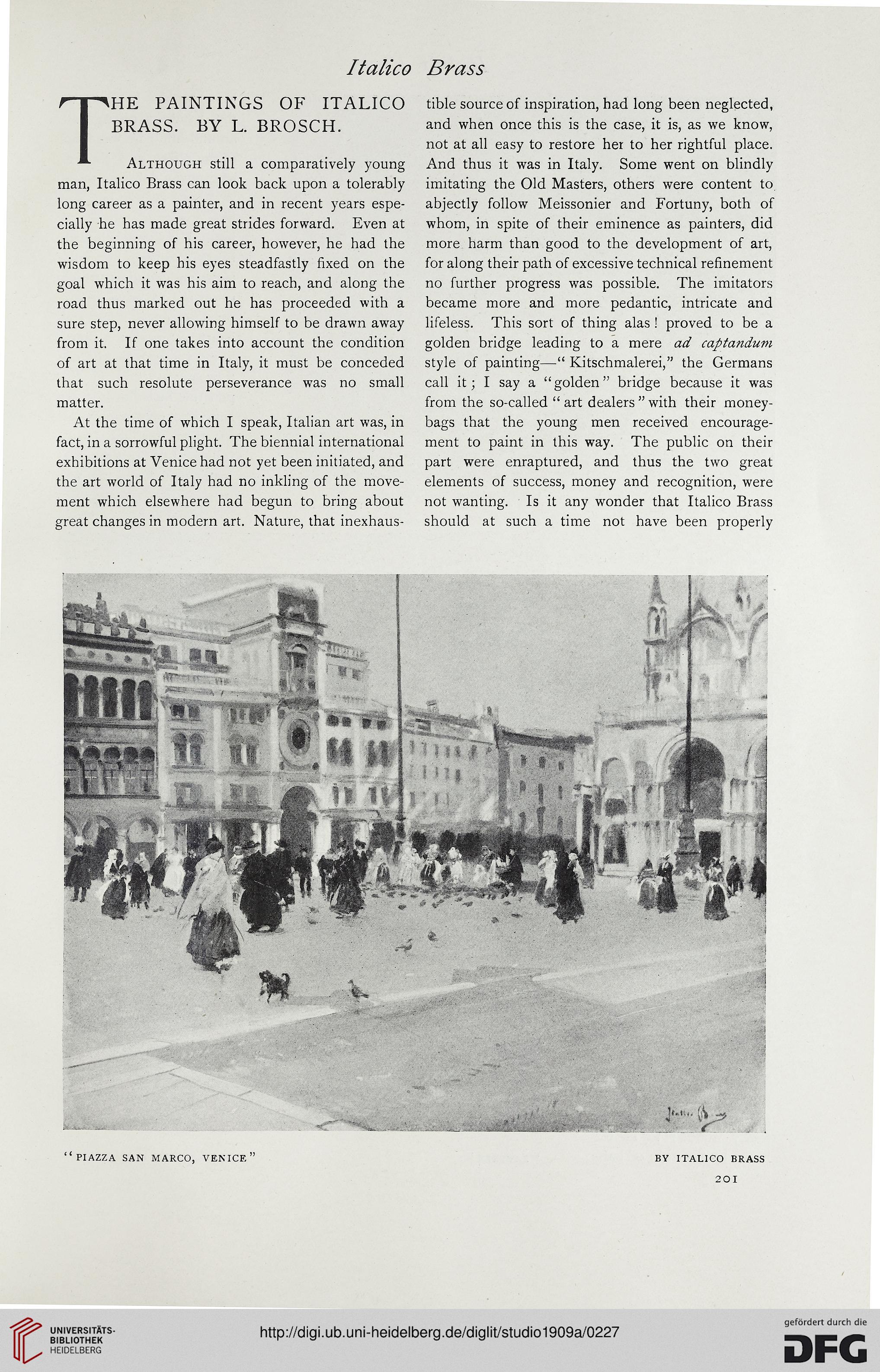Italico Brass
T
HE PAINTINGS OP' ITALICO
BRASS. BY L. BROSCH.
Although still a comparatively young
man, Italico Brass can look back upon a tolerably
long career as a painter, and in recent years espe-
cially he has made great strides forward. Even at
the beginning of his career, however, he had the
wisdom to keep his eyes steadfastly fixed on the
goal which it was his aim to reach, and along the
road thus marked out he has proceeded with a
sure step, never allowing himself to be drawn away
from it. If one takes into account the condition
of art at that time in Italy, it must be conceded
that such resolute perseverance was no small
matter.
At the time of which I speak, Italian art was, in
fact, in a sorrowful plight. The biennial international
exhibitions at Venice had not yet been initiated, and
the art world of Italy had no inkling of the move-
ment which elsewhere had begun to bring about
great changes in modern art. Nature, that inexhaus-
tible source of inspiration, had long been neglected,
and when once this is the case, it is, as we know,
not at all easy to restore her to her rightful place.
And thus it was in Italy. Some went on blindly
imitating the Old Masters, others were content to
abjectly follow Meissonier and Fortuny, both of
whom, in spite of their eminence as painters, did
more harm than good to the development of art,
for along their path of excessive technical refinement
no further progress was possible. The imitators
became more and more pedantic, intricate and
lifeless. This sort of thing alas ! proved to be a
golden bridge leading to a mere ad captandum
style of painting—“ Kitschmalerei,” the Germans
call it; I say a “golden” bridge because it was
from the so-called “ art dealers ” with their money-
bags that the young men received encourage-
ment to paint in this way. The public on their
part were enraptured, and thus the two great
elements of success, money and recognition, were
not wanting. Is it any wonder that Italico Brass
should at such a time not have been properly
“PIAZZA SAN MARCO, VENICE
BY ITALICO BRASS
201
T
HE PAINTINGS OP' ITALICO
BRASS. BY L. BROSCH.
Although still a comparatively young
man, Italico Brass can look back upon a tolerably
long career as a painter, and in recent years espe-
cially he has made great strides forward. Even at
the beginning of his career, however, he had the
wisdom to keep his eyes steadfastly fixed on the
goal which it was his aim to reach, and along the
road thus marked out he has proceeded with a
sure step, never allowing himself to be drawn away
from it. If one takes into account the condition
of art at that time in Italy, it must be conceded
that such resolute perseverance was no small
matter.
At the time of which I speak, Italian art was, in
fact, in a sorrowful plight. The biennial international
exhibitions at Venice had not yet been initiated, and
the art world of Italy had no inkling of the move-
ment which elsewhere had begun to bring about
great changes in modern art. Nature, that inexhaus-
tible source of inspiration, had long been neglected,
and when once this is the case, it is, as we know,
not at all easy to restore her to her rightful place.
And thus it was in Italy. Some went on blindly
imitating the Old Masters, others were content to
abjectly follow Meissonier and Fortuny, both of
whom, in spite of their eminence as painters, did
more harm than good to the development of art,
for along their path of excessive technical refinement
no further progress was possible. The imitators
became more and more pedantic, intricate and
lifeless. This sort of thing alas ! proved to be a
golden bridge leading to a mere ad captandum
style of painting—“ Kitschmalerei,” the Germans
call it; I say a “golden” bridge because it was
from the so-called “ art dealers ” with their money-
bags that the young men received encourage-
ment to paint in this way. The public on their
part were enraptured, and thus the two great
elements of success, money and recognition, were
not wanting. Is it any wonder that Italico Brass
should at such a time not have been properly
“PIAZZA SAN MARCO, VENICE
BY ITALICO BRASS
201





